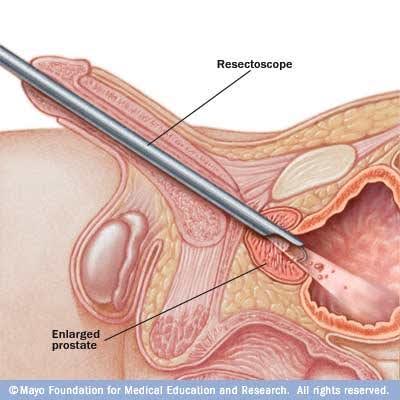The prostate is a small gland located deep within the pelvis and is found only in males. It sits just below the bladder, and the urethra (the tube that carries urine out of the body) passes directly through it. Because of this close relationship, certain prostate conditions can lead to urinary symptoms.
The prostate plays an important role in reproduction by producing seminal fluid, which mixes with sperm to form semen and supports sperm health and mobility.
Benign Prostatic Hyperplasia (BPH)
Benign Prostatic Hyperplasia (BPH) is a non-cancerous enlargement of the prostate gland and affects up to 50% of men over the age of 50. While not life-threatening, BPH can lead to bothersome urinary symptoms that may significantly impact quality of life. If left untreated, it can occasionally lead to more serious complications.
Because urinary symptoms are common and may be caused by various conditions, it is important to accurately differentiate BPH from other possible causes.
At Urology SA, our urologists provide a personalised, patient-focused approach. Each individual undergoes a thorough evaluation to determine the underlying cause of their symptoms. Based on this assessment, we will explain the most appropriate treatment options available to you.
We offer the full spectrum of world-class medical and surgical treatments for BPH, tailored to meet the unique needs of each patient.
Frequent or urgent need to urinate
- Weak or interrupted urine stream
- Difficulty starting urination or straining
- Feeling of incomplete bladder emptying
- Nocturia (waking at night to urinate)
What Causes Benign Prostatic Hyperplasia (BPH)?
The exact cause of BPH is not fully understood, but several factors appear to contribute:
- Genetics and Hormonal Changes: There is likely a genetic component, with family history and racial background influencing risk. BPH may also be linked to changes in the balance of male sex hormones (such as testosterone and dihydrotestosterone) that occur with aging.
- Lifestyle and Diet: Emerging evidence suggests that diet and lifestyle factors may play a role in the development or progression of BPH.
- Age-Related Enlargement: BPH is a benign (non-cancerous) enlargement of the prostate that most men experience to some degree as they age.
- Urethral Obstruction: As the prostate enlarges, it can compress the urethra (the tube that carries urine from the bladder), leading to urinary symptoms.
- Gradual Onset: Symptoms often develop slowly and may go unnoticed until they become more bothersome or advanced. It’s not uncommon for men to seek help only after significant symptoms have developed.

What Are the Symptoms of Benign Prostatic Hyperplasia (BPH)?
The symptoms of BPH can vary in type and severity. Common symptoms include:
- Difficulty starting urination or straining to begin
- Weak or interrupted urine flow
- A sensation of incomplete bladder emptying
- Frequent urination, including needing to urinate at night (nocturia)
- A sudden, urgent need to urinate
- Dribbling at the end of urination
Less common but more serious symptoms, which require immediate medical attention, may include:
- Blood in the urine*
- Complete inability to urinate (urinary retention)
- Urinary tract infection (which can lead to sepsis)
- Painful urination*
*Note: Blood in the urine or painful urination should always be investigated to rule out other conditions.
How is benign prostatic hyperplasia (BPH) diagnosed?
To diagnose BPH, the Urologists at Urology SA will take a thorough history to assess the nature and severity of your symptoms. Your Urologist will perform an examination and arrange further investigations as necessary which may include:
- Questionnaire (IPSS*) which will assist in making the diagnosis as well as monitoring your response to treatment
- Mid-stream urine test – to exclude infection or blood in urine
- PSA blood test
- Renal tract ultrasound – to assess prostate size, bladder emptying and kidney health
- Flow rate – to measure your urine flow and bladder emptying
- Flexible cystoscopy
What Are the Treatment Options for Benign Prostatic Hyperplasia (BPH)?
There is no one-size-fits-all approach to managing BPH. Treatment is tailored to each patient based on the severity of symptoms, prostate size, overall health, and personal preferences. At Urology SA, our urologists provide a comprehensive assessment and offer the full range of world-class medical and surgical treatment options.
Medical Therapy
- Alpha Blockers (e.g. Prazosin, Tamsulosin, Silodosin)
- Provide symptom relief by relaxing the bladder neck and prostate.
- Do not shrink the prostate or halt disease progression.
- Possible side effects: dizziness, low blood pressure, fatigue, or retrograde ejaculation.
- 5-Alpha Reductase Inhibitors (e.g. Dutasteride, Finasteride)
- Reduce prostate size by up to 25% over 6–9 months by altering hormone levels.
- May reduce symptoms and the need for surgery.
- Side effects in up to 10% of men: reduced libido, erectile dysfunction (which may be long-term).
- Combination Therapy (e.g. Duodart – Tamsulosin + Dutasteride)
- More effective than either medication alone.
- Maximum benefit seen after 6–9 months.
- Combines the benefits and side effects of both drugs.
Minimally Invasive Procedures
- Rezum Therapy: Uses steam energy to shrink excess prostate tissue.
- UroLift System: Implants that hold the enlarged prostate tissue away from the urethra, relieving obstruction without cutting or removing tissue.
Surgical Options
- Transurethral Resection of the Prostate (TURP): A common procedure that removes prostate tissue via a scope inserted through the urethra.
- Holmium Laser Enucleation of the Prostate (HoLEP): Laser-based removal of obstructive prostate tissue with minimal bleeding.
- GreenLight Laser Ablation: Vaporizes excess prostate tissue using high-powered laser energy.
